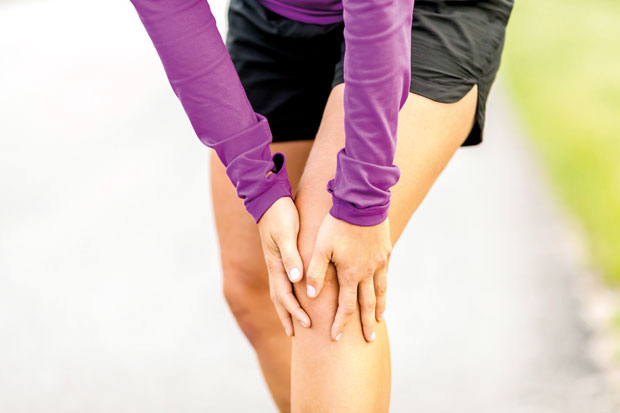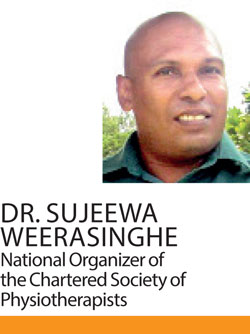
 There are different kinds of programs conducted to prevent non-communicable diseases in
There are different kinds of programs conducted to prevent non-communicable diseases in
Sri Lanka as well as around the world. But the majority of elders suffer from osteoarthritis of the knee joint worldwide. Your knee is the largest joint in the body. It is also one of the most complicated joints. It needs to be strong enough to carry our weight and must lock into position for us to stand upright. But it also has to act as a hinge, so we can walk. And it must withstand extreme stresses, twists and turns, actions common when we run or play sports. When your knee has osteoarthritis its surfaces become damaged and it doesn’t move as well as it should do. Evidence shows that being overweight increases the strain on the joints – especially the knees. Being overweight not only increases your risk of developing osteoarthritis, but also makes it more likely that your arthritis will worsen over time. Because of the way your joints work, the force put on your knees when you walk- especially on stairs and slopes- can be several times your actual body weight. Losing even a small amount of weight can make a big difference to the strain placed on your weight-bearing joints. Health Capsule spoke to Dr. Sujeewa Weerasinghe, National Organizer of the Chartered Society of Physiotherapists, to educate readers on how to manage a knee that gives trouble.
How the joint is damaged 
The cartilage becomes rough and thin. This condition can develop on the main surface of your knee joint and in the cartilage underneath your kneecap. The bone underneath the cartilage reacts by growing thicker and becoming broader. All the tissues in your joint become more active than normal, as if your body is trying to repair the damage. The bone at the edge of your joint grows outwards, forming bony spurs called osteophytes. The synovium may swell and produce extra fluid, causing the joint to swell – this is called an effusion or sometimes water in the knee. The capsule and ligaments slowly thicken and contract.
These changes in and around your joint are partly the result of the inflammatory process and partly an attempt by your body to repair the damage. In many cases the repairs that the body initiates within are quite successful. The changes inside your joint won’t cause much pain or, if there is pain, it’ll be mild and may come and go. However, in other cases the repair doesn’t work as well and your knee is damaged. This leads to instability and more weight being put onto other parts of the joint. This can cause symptoms to gradually worsen and be more persistent over time.The main symptoms of osteoarthritis of the knee are:
Pain (particularly when you’re moving your knees or at the end of the day – this usually gets better when you rest)
Stiffness (especially after rest – this usually eases after a minute or so as you get moving)
Crepitus, a creaking, crunching, grinding sensation when you move the joint.
Hard swellings (caused by osteophytes)
Soft swellings (caused by extra fluid in the joint).
Other symptoms can include:
Your knee giving way because your muscles have become weak or the joint structure is less stable
Your knee not moving as freely or as far as normal
Your knees becoming bent and bowed
The muscles around your joint looking thin or wasted. It’s unusual, but some people have pain in their knee that wakes them up at night. This generally only happens with severe osteoarthritis.
You’ll probably find that your pain will vary and that you have good days and bad days, sometimes depending on how active you’ve been, but sometimes for no clear reason.
Some people find that changes in the weather (especially damp weather and low pressure) make their pain and stiffness worse. This may be because nerve fibers in the capsule of their knee are sensitive to changes in atmospheric pressure.
Many factors can increase your risk of osteoarthritis of the knee. It’s most common if:
You’re in your late 40s or older – this might be because your muscles have become weaker, your body is less able to heal itself or your joints have gradually worn out over time
You’re a woman – osteoarthritis is more common and more severe in women
You’re overweight – this increases the chances of developing osteoarthritis and of it becoming
gradually worse
Your parents or siblings have had osteoarthritis
You’ve had a knee injury, for example a torn meniscus
You’ve had an operation on your knee, for example a meniscectomy (to remove damaged cartilage) or repairs to your cruciate ligaments
You do a hard, repetitive activity or a physically demanding job, for example farming or mining
You have another type of joint disease which has damaged your joints, for example rheumatoid arthritis or gout.
Arthritis Research UK has recently awarded a grant to investigate the use of new drugs to treat early-onset osteoarthritis, caused by injury.
There’s no cure for osteoarthritis as yet, but there’s a lot that you can do to improve your symptoms and reduce the chances of your arthritis becoming worse
It’s very important to keep your joints moving. You need to find the right balance between rest and exercise – little and often is usually the best approach.
There are two types of exercise that you need to do:
A physiotherapist can advise you on the best exercises, but you’ll need to build them into your daily routine to get the maximum benefit from them. You can also talk to your GP about the Exercise on Prescription scheme that’s available in some areas. Swimming is very good for people with osteoarthritis because the water supports your weight. In this form of exercise you won’t put a undue strain on the joints. Hydrotherapy (exercises in a warm water) can help get muscles and joints working, and it can be very relaxing.
If you know you’re going to be more active than usual, try taking a painkiller before you start to avoid increased pain later.
Apart from watching your weight, there are a number of other ways you can reduce the strain on your joints:
- Pace your activities through the day – don’t tackle all the physical jobs at once. Break up the harder jobs and do something gentler in between. A chart can help you plan your daily activities and monitor them when they cause extreme tiredness (fatigue) or affect your symptoms.
- Wear low-heeled shoes with soft, thick soles (trainers are ideal). Thicker soles will act as shock absorbers for your feet, knees, hips and back. High heels will alter the angle of your hips, knees and big toe joints and put extra strain on them. Use a walking stick to reduce the weight and stress placed on a painful hip or knee. A therapist or doctor can advise you on the correct length and the best way to use the stick.
- Use the handrail for support when climbing stairs. Go upstairs one step at a time with your good leg first.
- Don’t keep your knee still in a bent position for too long as this will affect your muscles.
- Think about modifying your home, car or workplace to reduce unnecessary strain on your joints. An occupational therapist can offer advise on how to protect the joints and feed you with information regarding special equipment or gadgets that will make your daily tasks easier.
- Learn to relax your muscles and release tension from your body. A physiotherapist or occupational therapist can advise you on relaxation techniques.
- Use heat/ice packs to help ease pain and stiffness. Heat lamps are popular, but a hot-water bottle or repeatable pad are just as good. A pack of frozen peas can be used as an ice pack. They can be helpful if you have a flare-up of pain when you’ve done a bit too much. Don’t apply ice or heat packs directly to your skin!
More evidence to support the use of knee braces for osteoarthritis is becoming available. Several types of braces can help to stabilize your kneecap and make it move correctly. You can buy knee braces from sports shops and chemists, but you should speak to your doctor or physiotherapist first. They may also be able to provide braces or recommend the best ones for you.

 There are different kinds of programs conducted to prevent non-communicable diseases in
There are different kinds of programs conducted to prevent non-communicable diseases in 
